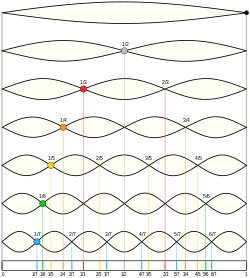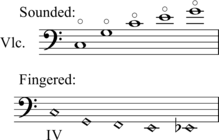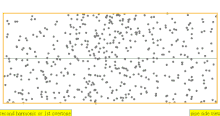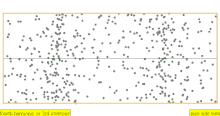Harmonic


A harmonic of a wave is a component frequency of the signal that is an integer multiple of the fundamental frequency, i.e. if the fundamental frequency is f, the harmonics have frequencies 2f, 3f, 4f, . . . etc. The harmonics have the property that they are all periodic at the fundamental frequency, therefore the sum of harmonics is also periodic at that frequency. Harmonic frequencies are equally spaced by the width of the fundamental frequency and can be found by repeatedly adding that frequency. For example, if the fundamental frequency (first harmonic) is 25 Hz, the frequencies of the next harmonics are: 50 Hz (2nd harmonic), 75 Hz (3rd harmonic), 100 Hz (4th harmonic) etc.
Characteristics
Many oscillators, including the human voice, a bowed violin string, or a Cepheid variable star, are more or less periodic, and so composed of harmonics, also known as harmonic partials.
Most passive oscillators, such as a plucked guitar string or a struck drum head or struck bell, naturally oscillate at not one, but several frequencies known as partials. When the oscillator is long and thin, such as a guitar string, or the column of air in a trumpet, many of the partials are integer multiples of the fundamental frequency; these are called harmonics. Sounds made by long, thin oscillators are for the most part arranged harmonically, and these sounds are generally considered to be musically pleasing. Partials whose frequencies are not integer multiples of the fundamental are referred to as inharmonic partials. Instruments such as cymbals, pianos, and strings plucked pizzicato create inharmonic sounds.[1][2]
The untrained human ear typically does not perceive harmonics as separate notes. Rather, a musical note composed of many harmonically related frequencies is perceived as one sound, the quality, or timbre of that sound being a result of the relative strengths of the individual harmonic frequencies. Bells have more clearly perceptible inharmonics than most instruments. Antique singing bowls are well known for their unique quality of producing multiple harmonic partials or multiphonics.
Harmonics and overtones
The tight relation between overtones and harmonics in music often leads to their being used synonymously in a strictly musical context, but they are counted differently leading to some possible confusion. This chart demonstrates how they are counted:
| Frequency | Order | Name 1 | Name 2 | Wave Representation | Molecular Representation |
|---|---|---|---|---|---|
| 1 · f = 440 Hz | n = 1 | fundamental tone | 1st harmonic | 
|

|
| 2 · f = 880 Hz | n = 2 | 1st overtone | 2nd harmonic | 
|

|
| 3 · f = 1320 Hz | n = 3 | 2nd overtone | 3rd harmonic | 
|

|
| 4 · f = 1760 Hz | n = 4 | 3rd overtone | 4th harmonic | 
|

|
Harmonics are not overtones, when it comes to counting. Even numbered harmonics are odd numbered overtones and vice versa.
In many musical instruments, it is possible to play the upper harmonics without the fundamental note being present. In a simple case (e.g., recorder) this has the effect of making the note go up in pitch by an octave; but in more complex cases many other pitch variations are obtained. In some cases it also changes the timbre of the note. This is part of the normal method of obtaining higher notes in wind instruments, where it is called overblowing. The extended technique of playing multiphonics also produces harmonics. On string instruments it is possible to produce very pure sounding notes, called harmonics or flageolets by string players, which have an eerie quality, as well as being high in pitch. Harmonics may be used to check at a unison the tuning of strings that are not tuned to the unison. For example, lightly fingering the node found halfway down the highest string of a cello produces the same pitch as lightly fingering the node 1/3 of the way down the second highest string. For the human voice see Overtone singing, which uses harmonics.
While it is true that electronically produced periodic tones (e.g. square waves or other non-sinusoidal waves) have "harmonics" that are whole number multiples of the fundamental frequency, practical instruments do not all have this characteristic. For example higher "harmonics"' of piano notes are not true harmonics but are "overtones" and can be very sharp, i.e. a higher frequency than given by a pure harmonic series. This is especially true of instruments other than stringed or brass/woodwind ones, e.g., xylophone, drums, bells etc., where not all the overtones have a simple whole number ratio with the fundamental frequency.
The fundamental frequency is the reciprocal of the period of the periodic phenomenon.
![]() This article incorporates public domain material from Federal Standard 1037C. General Services Administration. Archived from the original on 2022-01-22.
This article incorporates public domain material from Federal Standard 1037C. General Services Administration. Archived from the original on 2022-01-22.
Harmonics on stringed instruments

The following table displays the stop points on a stringed instrument, such as the guitar (guitar harmonics), at which gentle touching of a string will force it into a harmonic mode when vibrated. String harmonics (flageolet tones) are described as having a "flutelike, silvery quality that can be highly effective as a special color" when used and heard in orchestration.[3] It is unusual to encounter natural harmonics higher than the fifth partial on any stringed instrument except the double bass, on account of its much longer strings.[4]
| Harmonic | Stop note | Sounded note relative to open string | Cents above open string | Cents reduced to one octave | Audio |
|---|---|---|---|---|---|
| 2 | octave | octave (P8) | 1,200.0 | 0.0 | |
| 3 | just perfect fifth | P8 + just perfect fifth (P5) | 1,902.0 | 702.0 | |
| 4 | second octave | 2P8 | 2,400.0 | 0.0 | |
| 5 | just major third | 2P8 + just major third (M3) | 2,786.3 | 386.3 | |
| 6 | just minor third | 2P8 + P5 | 3,102.0 | 702.0 | |
| 7 | septimal minor third | 2P8 + septimal minor seventh (m7) | 3,368.8 | 968.8 | |
| 8 | septimal major second | 3P8 | 3,600.0 | 0.0 | |
| 9 | Pythagorean major second | 3P8 + Pythagorean major second (M2) | 3,803.9 | 203.9 | |
| 10 | just minor whole tone | 3P8 + just M3 | 3,986.3 | 386.3 | |
| 11 | greater unidecimal neutral second | 3P8 + lesser undecimal tritone | 4,151.3 | 551.3 | |
| 12 | lesser unidecimal neutral second | 3P8 + P5 | 4,302.0 | 702.0 | |
| 13 | tridecimal 2/3-tone | 3P8 + tridecimal neutral sixth (n6) | 4,440.5 | 840.5 | |
| 14 | 2/3-tone | 3P8 + P5 + septimal minor third (m3) | 4,568.8 | 968.8 | |
| 15 | septimal (or major) diatonic semitone | 3P8 + just major seventh (M7) | 4,688.3 | 1,088.3 | |
| 16 | just (or minor) diatonic semitone | 4P8 | 4,800.0 | 0.0 |
Table

Artificial harmonics
Although harmonics are most often used on open strings, occasionally a score will call for an artificial harmonic: playing an overtone on a stopped string. This must be accomplished using two fingers on the fingerboard, one to shorten the string to the desired fundamental, and the other touching the node corresponding to the appropriate harmonic.
Other information
Harmonics may be either used or considered as the basis of just intonation systems. Composer Arnold Dreyblatt is able to bring out different harmonics on the single string of his modified double bass by slightly altering his unique bowing technique halfway between hitting and bowing the strings. Composer Lawrence Ball uses harmonics to generate music electronically.
See also
- Aristoxenus
- Artificial harmonic
- Harmonics (electrical power)
- Electronic tuner
- Formant
- Fourier series
- Harmonic oscillator
- Harmony
- Pinch harmonic
- Pure tone
- Pythagorean tuning
- Scale of harmonics
- Spherical harmonics
- Stretched octave
- Subharmonic
- Tap harmonic
- Xenharmonic
References
- ^ Acoustical Society of America - Large grand and small upright pianos by Alexander Galembo and Lola L. Cuddly
- ^ Matti Karjalainen (1999). "Audibility of Inharmonicity in String Instrument Sounds, and Implications to Digital Sound Systems"
- ^ Kennan, Kent and Grantham, Donald (2002/1952). The Technique of Orchestration, p.69. Sixth Edition. ISBN 0-13-040771-2.
- ^ Kennan & Grantham, ibid, p.71.
External links
- Harmonics, partials and overtones from fundamental frequency
- Discussion of Sciarrino's violin etudes and notation issues
- Chisholm, Hugh, ed. (1911). . Encyclopædia Britannica (11th ed.). Cambridge University Press.
- Harmonics


